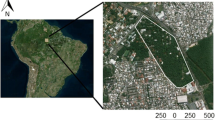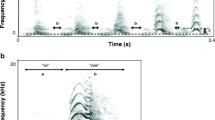Abstract
Male copulation calls sometimes play important roles in sexual strategies, attracting conspecific females or advertising their social status to conspecific males. These calls generally occur in sexually competitive societies such as harem groups and multi-male and multi-female societies. However, the call functions remain unclear because of limited availability of data sets that include a large number of male and female animals in naturalistic environments, particularly in primates. Here, we examined the possible function of male-specific copulation calls in wild stump-tailed macaques (Macaca arctoides) by analyzing the contexts and acoustic features of vocalizations. We observed 395 wild stump-tailed macaques inhabiting the Khao Krapuk Khao Taomor Non-Hunting Area in Thailand and recorded all occurrences of observed copulations. We counted 446 male-specific calls in 383 copulations recorded, and measured their acoustic characteristics. Data were categorized into three groups depending on their social status: dominant (alpha and coalition) males and non-dominant males. When comparing male status, alpha males most frequently produced copulation calls at ejaculation, coalition males produced less frequent calls than alpha males, and other non-dominant males rarely vocalized, maintaining silence even when mounting females. Acoustic analysis indicated no significant influence of status (alpha or coalition) on call number, bout duration, or further formant dispersion parameters. Our results suggest that male copulation calls of this species are social status-dependent signals. Furthermore, dominant males might actively transmit their social status and copulations to other male rivals to impede their challenging attacks, while other non-dominant males maintain silence to prevent the interference of dominants.





Similar content being viewed by others
Change history
23 May 2020
In the original publication of the article the affiliations 1 and 3 were incorrectly published. The correct affiliations are given in this correction.
Notes
The social tactics of “coalition” in stump-tailed macaques in this area are highly interesting, but the analysis, results, and discussions of these social tactics should be reported in another paper. Accordingly, we did not mention the details of the coalition phenomena, and only cited our preprint manuscript (Toyoda et al. 2020), including the actual data and its tentative discussions.
See the legend for Table 1.
References
Andersson MB (1994) Sexual selection. Princeton University Press, Princeton
Aujard F, Heistermann M, Thierry B, Hodges JK (1998) Functional significance of behavioral, morphological, and endocrine correlates across the ovarian cycle in semifree ranging female Tonkean macaques. Am J Primatol 46:285–309. https://doi.org/10.1002/(SICI)1098-2345(1998)46:4%3c285:AID-AJP2%3e3.0.CO;2-8
Bernstein SK, Sheeran LK, Wagner RS et al (2016) The vocal repertoire of Tibetan macaques (Macaca thibetana): a quantitative classification. Am J Primatol 78:937–949. https://doi.org/10.1002/ajp.22564
Blurton Jones NG, Trollope J (1968) Social behaviour of stump-tailed macaques in captivity. Primates 9:365–393
Bradbury JW, Vehrencamp SL (1998) Principles of animal communication. Sinauer Associates, Massachusetts
Catchpole CK, Slater PJB (2003) Bird song: biological themes and variations. Cambridge University Press, Cambridge
Charlton B, Ellis WA, Brumm J et al (2012) Female koalas prefer bellows in which lower formants indicate larger males. Anim Behav 84:1565–1571
Charlton BD, Reby D (2016) The evolution of acoustic size exaggeration in terrestrial mammals. Nat Commun 7:12739. https://doi.org/10.1038/ncomms12739
Charlton BD, Reby D, McComb K (2007) Female red deer prefer the roars of larger males. Biol Lett 3:382–385. https://doi.org/10.1098/rsbl.2007.0244
Charlton BD, Zhihe Z, Snyder RJ (2010) Giant pandas perceive and attend to formant frequency variation in male bleats. Anim Behav 79:1221–1227. https://doi.org/10.1016/j.anbehav.2010.02.018
Chevalier-Skolnikoff S (1975) Heterosexual copulatory patterns in stumptail macaques (Macaca arctoides) and in other macaque species. Arch Sex Behav 4:199–220. https://doi.org/10.1007/BF01541083
Darwin C (1871) The descent of man, and selection in relation to sex. John Murray, London
Dixson AF (1983) Observations on the evolution and behavioral significance of “sexual skin” in female primates. In: Advances in the study of behavior, pp 63–106
Dixson AF (2012) Primate sexuality: comparative studies of the prosimians, monkeys, apes, and humans. Oxford University Press, Oxford
Dunn JC, Halenar LB, Davies TG et al (2015) Evolutionary trade-off between vocal tract and testes dimensions in howler monkeys. Curr Biol. https://doi.org/10.1016/j.cub.2015.09.029
Estep DQ, Bruce KEM, Johnston ME, Gordon TP (1984) Sexual behavior of group-housed stumptail macaques (Macaca arctoides): temporal, demographic and sociosexual relationships. Folia Primatol 42:115–126. https://doi.org/10.1159/000156154
Fant G (1970) Acoustic theory of speech production—with calculations based on X-Ray studies of Russian articulations. Mouton & Co. N. V., Publishers, The Hague, Paris
Fitch WT (1997) Vocal tract length and formant frequency dispersion correlate with body size in rhesus macaques. J Acoust Soc Am 102:1213–1222. https://doi.org/10.1121/1.421048
Fitch WT, Reby D (2001) The descended larynx is not uniquely human. Proc R Soc London Ser B Biol Sci 268:1669–1675
Fooden J (1990) The bear macaque, Macaca arctoides: a systematic review. J Hum Evol 19:607–686. https://doi.org/10.1016/0047-2484(90)90002-S
Fooden J (1967) Complementary specialization of male and female reproductive structures in the bear macaque, Macaca arctoides. Nature 214:939–941. https://doi.org/10.1038/214939b0
Gouzoules H, Gust DA, Donaghey B, St AE (1998) Estrus vocalizations in two primate species (Cercocebus Torquatus Atys and Macaca Nemestrina). Evol Commun 2:189–215. https://doi.org/10.1075/eoc.2.2.03gou
Hamilton W, Arrowood P (1978) Copulatory vocalizations of chacma baboons (Papio ursinus), gibbons (Hylobates hoolock), and humans. Science 200:1405–1409. https://doi.org/10.1126/science.663622
Harris TR, Fitch WT, Goldstein LM, Fashing PJ (2006) Black and white colobus monkey (Colobus guereza) roars as a source of both honest and exaggerated information about body mass. Ethology 112:911–920. https://doi.org/10.1111/j.1439-0310.2006.01247.x
Hauser MD (1993a) Rhesus monkey copulation calls: honest signals for female choice? Proc R Soc London Ser B Biol Sci 254:93–96. https://doi.org/10.1098/rspb.1993.0132
Hauser MD (1993b) The evolution of nonhuman primate vocalizations: effects of phylogeny, body weight, and social context. Am Nat 142:528–542. https://doi.org/10.1086/285553
Hauser MD (2007) When males call, females listen: sex differences in responsiveness to rhesus monkey, Macaca mulatta, copulation calls. Anim Behav 73:1059–1065. https://doi.org/10.1016/j.anbehav.2006.11.006
Hohmann GM, Herzog MO (1985) Vocal communication in lion-tailed macaques (Macaca silenus). Folia Primatol 45:148–178. https://doi.org/10.1159/000156226
Huchard E, Courtiol A, Benavides JA et al (2009) Can fertility signals lead to quality signals? Insights from the evolution of primate sexual swellings. Proc R Soc B Biol Sci 276:1889–1897. https://doi.org/10.1098/rspb.2008.1923
Koda H (2016) Gibbon songs: Understanding the evolution and development of this unique form of vocal communication. In: Reichard UH, Hirai H, Barelli C (eds) Evolution of Gibbons and Siamang. Springer, Berlin, pp 347–357
Koda H, Lemasson A, Oyakawa C et al (2013) Possible role of mother-daughter vocal interactions on the development of species-specific song in gibbons. PLoS ONE 8:e71432. https://doi.org/10.1371/journal.pone.0071432
Koda H, Murai T, Tuuga A et al (2018) Nasalization by Nasalis larvatus: larger noses audiovisually advertise conspecifics in proboscis monkeys. Sci Adv 4:eaaq0250. https://doi.org/10.1126/sciadv.aaq0250
Koda H, Nishimura T, Tokuda IT et al (2012) Soprano singing in gibbons. Am J Phys Anthropol 149:347–355. https://doi.org/10.1002/ajpa.22124
Lindburg DG (1990) Proceptive calling by female lion-tailed macaques. Zoo Biol 9:437–446. https://doi.org/10.1002/zoo.1430090605
Maestripieri D, Roney JR (2005) Primate copulation calls and postcopulatory female choice. Behav Ecol 16:106–113. https://doi.org/10.1093/beheco/arh120
Manson JH (1996) Rhesus macaque copulation calls: re-evaluating the “honest signal” hypothesis. Primates 37:145–154. https://doi.org/10.1007/BF02381402
Matsumura S (1999) The evolution of “egalitarian” and “despotic” social systems among macaques. Primates 40:23–31. https://doi.org/10.1007/BF02557699
McComb K, Semple S (2005) Coevolution of vocal communication and sociality in primates. Biol Lett 1:381–385. https://doi.org/10.1098/rsbl.2005.0366
Moos-Heilen R, Sossinka R (2010) The influence of oestrus on the vocalization of female gelada baboons (Theropithecus gelada). Ethology 84:35–46. https://doi.org/10.1111/j.1439-0310.1990.tb00783.x
Nunn CL (1999) The evolution of exaggerated sexual swellings in primates and the graded-signal hypothesis. Anim Behav 58:229–246. https://doi.org/10.1006/anbe.1999.1159
Nunn CL, van Schaik CP, Zinner D (2001) Do exaggerated sexual swellings function in female mating competition in primates? A comparative test of the reliable indicator hypothesis. Behav Ecol 12:646–654
O’Connell SM, Cowlishaw G (1994) Infanticide avoidance, sperm competition and mate choice: the function of copulation calls in female baboons. Anim Behav 48:687–694. https://doi.org/10.1006/anbe.1994.1288
Pandit SA, van Schaik CP (2003) A model for leveling coalitions among primate males: toward a theory of egalitarianism. Behav Ecol Sociobiol 55:161–168. https://doi.org/10.1007/s00265-003-0692-2
Pradhan GR, Engelhardt A, van Schaik CP, Maestripieri D (2006) The evolution of female copulation calls in primates: a review and a new model. Behav Ecol Sociobiol 59:333–343. https://doi.org/10.1007/s00265-005-0075-y
Reby D, McComb K, Cargnelutti B et al (2005) Red deer stags use formants as assessment cues during intrasexual agonistic interactions. Proc Biol Sci 272:941–947. https://doi.org/10.1098/rspb.2004.2954
Ryan M (1980) Female mate choice in a neotropical frog. Science 209:523–525
Saayman GS (1970) The menstrual cycle and sexual behaviour in a troop of free ranging chacma baboons (Papio ursinus). Folia Primatol 12:81–110. https://doi.org/10.1159/000155283
Thierry B, Singh M, Kaumanns W (2004) Macaque societies: a model for the study of social organization. Cambridge University Press, Cambridge
Tosi AJ, Morales JC, Melnick DJ (2003) Paternal, maternal, and biparental molecular markers provide unique windows onto the evolutionary history of macaque monkeys. Evolution 57:1419–1435
Tosi AJ, Morales JC, Melnick DJ (2000) Comparison of Y chromosome and mtDNA phylogenies leads to unique inferences of macaque evolutionary history. Mol Phylogenet Evol 17:133–144. https://doi.org/10.1006/mpev.2000.0834
Toyoda A, Malaivijitnond S (2018) The first record of dizygotic twins in semi-wild stump-tailed macaques (Macaca arctoides) tested using microsatellite markers and the occurrence of supernumerary nipples. Mammal Study 43:207–212. https://doi.org/10.3106/ms2017-0081
Toyoda A, Maruhashi T, Malaivijitnond S et al (2020) Cooperation for copulation: a novel ecological mechanism underlying the evolution of coalition for sharing mating opportunitiesle. bioRxiv. https://doi.org/10.1101/2020.01.30.927772
Toyoda A, Maruhashi T, Malaivijitnond S, Koda H (2017) Speech-like orofacial oscillations in stump-tailed macaque (Macaca arctoides) facial and vocal signals. Am J Phys Anthropol 164:435–439. https://doi.org/10.1002/ajpa.23276
Zinner D, van Schaik CP, Nunn CL, Kappeler PM (2004) Sexual selection and exaggerated sexual swellings of female primates. In: Sexual selection in primates: new and comparative perspectives, pp 71–89
Acknowledgements
We are grateful to Warayut Nilpaung, Chuchat Choklap, the superintendent of the Khao Krapuk Khao Taomor Non-Hunting Area; Phanlerd Inprasoet, Wanchai Inprasoet, and Napatchaya Techaatiwatkun for providing valuable support that ensured the success of our fieldwork; Dr. Yuzuru Hamada, Dr. Takeshi Furuichi, Dr. Ikuma Adachi, and Dr. Takeshi Nishimura for their support in our research. Our deepest appreciation goes to three anonymous reviewers for their comments/suggestions. This study was funded by the JSPS KAKENHI (nos. 18H03503 and 16H04848 to HK, no. 16J0098 to AT, no. 19KK0191 to AT and HK), Young Science Explorer Grant of the National Geographic Foundation for Science and Exploration–Asia (to AT), Kyoto University Foundation (to AT), the Cooperative Research Programs of the Wildlife Research Center and Primate Research Institute, Kyoto University (to AT), Japan Science and Technology Agency Core Research for Evolutional Science and Technology 17941861 (no. JPMJCR17A4), and Ministry of Education, Culture, Sports, Science and Technology, Grant-in-Aid for Scientific Research on Innovative Areas no. 4903 (Evolinguistics) 17H06380 to HK (as co-PI).
Author information
Authors and Affiliations
Corresponding authors
Ethics declarations
Conflict of interest
The authors declare that they have no conflict of interest.
Informed consent
Not applicable for this study (due to wild animal study).
Additional information
Publisher's Note
Springer Nature remains neutral with regard to jurisdictional claims in published maps and institutional affiliations.
Electronic supplementary material
Below is the link to the electronic supplementary material.
Supplementary video S1. Sample video clips of a male copulatory vocalization episode in which an adult male (alpha male) is mounting a female (WMV 8739 kb)
About this article
Cite this article
Toyoda, A., Maruhashi, T., Malaivijitnond, S. et al. Dominance status and copulatory vocalizations among male stump-tailed macaques in Thailand. Primates 61, 685–694 (2020). https://doi.org/10.1007/s10329-020-00820-7
Received:
Accepted:
Published:
Issue Date:
DOI: https://doi.org/10.1007/s10329-020-00820-7




